Content created: 2009-05-13
File last modified:

Chinese Buddhist Mudrās
A Beginner's Guide
What's a Mudrā?
Any tradition of religious art involves some means by which important scenes and figures can be recognized. For example, in western art, Christian saints are usually accompanied with objects connected in some way to their lives, which serve to identify them. For this reason, Saint Peter is shown holding a key. Saint Jerome, the translator of the Bible into Latin, is accompanied by his books and by a lion he tamed. And so on.
Nowhere is the proliferation of religious figures and their symbols more complex than in southern Asia, where not only are there hundreds of divinities, but many have multiple avatars, all with their characteristic objects or gestures.
Chinese Buddhism is the heir to some of this tradition, and Chinese Buddhist temple statuary or other religious art is more easily appreciated if one has some idea what the system is like. Although general appearance and costuming do matter, one of the most interesting features is the use of characteristic gestures, called (following the Sanskrit imagery) yìn 印, “seals,” or shǒuyìn 手印, “hand seals” (Sanskrit: mudrā).
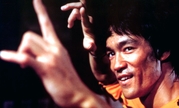
In addition to their appearance in art work, the mudras are in active use by priests and exorcists performing rituals of various kinds.
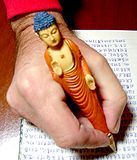
This page provides some examples of the most common ones, accounting for the vast majority of the gestures you will see in temples and museums.
Most of the gestures shown here are well known to a large number of Asian worshippers, and appear in popular culture derivations, like the "Ballpoint Buddha" shown at left, and in films, comic books, &c. (The picture above shows Bruce Lee, popular Chinese-American martial artist film star, whose martial arts poses often included finger gestures, although typically ones that were presented as secret.)
There are, however, many more, both one-handed and using two hands. An appendix to DĪNG Fúbǎo's 丁福保 Encyclopedic Dictionary of Buddhist Studies, cited below, provides pictures of 181 two-handed ones alone.
For present purposes, I have given each gesture an English name to make it easier to remember. Most English sources are organized by the Sanskrit terms or by Japanese versions of them.
When traditional Chinese characters differ from the standard simplified ones, they are printed afterward in blue. Sources of the pictures are identified in the “properties” accessible in some browsers by right-clicking on them, in others by various similar approaches.
List of Common Mudras
- Calming Gesture
-
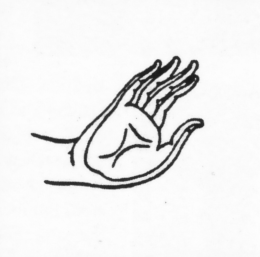 Abhaya Mudrā or Abhayaṃdada Mudrā
Abhaya Mudrā or Abhayaṃdada Mudrā - shīwúwèi yìn 施无畏印 / 施無畏印
- This gesture vanquishes both fear and hostility. It is said that once a vicious demon named Devadatta sent a drunken elephant to trample the Buddha. The Buddha raised his hand gently, and immediately the elephant was subdued. (This is probably a mythologized variant of the story told in chapter 25 of the on-line biography of the Buddha. [Link]) The mudrā has therefore come to represent protection and peace and the dissipation of all fear in the believer. (Some say it is a pre-Buddhist sign used in greeting another person and signaling one’s good intentions.) This mudrā is often combined with the Wish-Granting Gesture (varada mudrā)
- Demon-Quelling Gesture
-
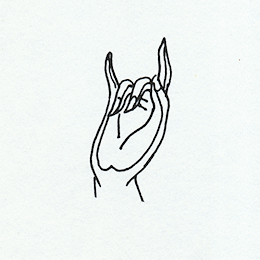 Kāraṇa Mudrā
Kāraṇa Mudrā - qīkè yìn 期克印
-
This gesture subdues negativity, including demons, negative thoughts, illness, and all other obstacles. It consists of holding up the hand, with the two middle fingers folded back into the palm and held by the thumb. In art it occurs in scenes of active conquest of demons. (Since there are a lot of demons in movies, you will see it there quite often.)
- (The Chinese name qīkè yìn 期克印, seems also to be used sometimes for the Warning Gesture or Tarjanī Mudrā.)
- Earth-Witness Gesture
-
 Bhūmisparśa Mudrā
Bhūmisparśa Mudrā - chùdì yìn 触地印 / 觸地印
- This gesture is literally called “touching the earth.” It is said that when the Buddha was meditating under the fig tree, he was approached by the lord of earthly illusion, Mara, who sought to divert him from his path to enlightenment. But the Buddha moved his right hand from his position of meditation (now called the Dhyāna mudrā) and pointed down and called upon the earth itself to witness that he had resolved the problem of suffering. Thus he turned away Mara and his temptations. (Some say that he called upon earth to testify to his victory over Mara.) (This is probably a mythologized variant of the story told in chapter 16 of the on-line biography of the Buddha. [Link])
- This is mudrā is not seen except in representations of the Buddha himself.
- Enlightenment Gesture
-
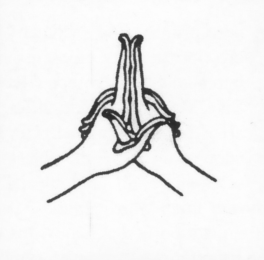 Uttarabodhi Mudrā
Uttarabodhi Mudrā - zuìgāo qǐdí yìn 最高启迪印 / 最高啟迪印
- This gesture represents highest enlightenment. Both hands are held at the level of the chest, the two raised index fingers touch one another, the remaining fingers are crossed and folded down.; the thumbs touch each other at the tips or are crossed and folded. This mudrā is frequently seen in images of the Buddha Vairocana (Pílú-zhènà fó 毘卢遮那佛 / 毘盧遮那佛 or 大日如來 Dàrì rúlái).
- Meditation Gesture
-
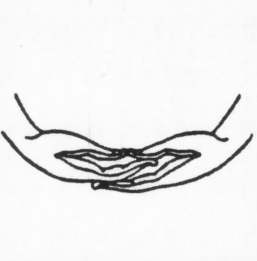 Dhyāna Mudrā
Dhyāna Mudrā - chándìng yìn 禅定印 / 禪定印 or dìng yìn 定印
- This gesture indicates meditation, or more exactly the highest state of tranquility (samādhi or sānmótí 三摩提). Although long used in India as a position for the hands during meditation, in Buddhist art this gesture is usually associated with buddhas, therefore usually Sakyamuni or Shìjiāmóuní fó 释迦牟尼佛 / 釋迦牟尼佛 and Amitābha or Ēmítuó fó 阿弥陀佛 / 阿彌陀佛.
- (A begging bowl may be held atop the hands. When a medicine bowl is shown there, the figure is often Bhaiṣajyaguru, known in Chinese as simply Yàoshī fó 药师佛 / 藥師佛, which means “Medicine Master Buddha,” associated with healing. Or it is Ēmítuó fó 阿弥陀佛 / 阿彌陀佛 (Amithābha), especially if both hands remain in the Meditation Gesture position. In some cases only one hand is used in order to free up the other hand to perform a different mudrā.)
- Reverence Gesture
-
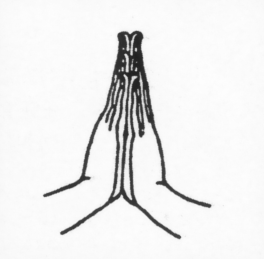 Añjali Mudrā or Vajra-Añalikarma Mudrā or Namaskara Mudrā
Añjali Mudrā or Vajra-Añalikarma Mudrā or Namaskara Mudrā - jīngāng hézhǎng 金刚合掌 / 金剛合掌 or héshí yìn 合十印
- This gesture indicates reverence and salutation. This gesture is used in India as a salutation. It is also so used among Chinese Buddhists in meeting clerics and among the nuns and monks themselves. (The Chinese term hézhǎng means “hand clasp” rather than mudrā.) It occasionally also occurs in non-Buddhist contexts. The two palms pressed together under the mouth are thought to indicate homage to the words of a teacher.
- Since the Buddha after his enlightenment owes homage to no person, representations of the Buddha rarely show him using this gesture (except toward his parents). Those who seek a deeper meaning see in the two hands placed together the union of the spiritual and material, the static and the dynamic, or even the yīn and the yáng.
- Strength Gesture
-
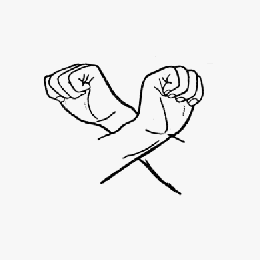 Vajrahūmkāra Mudrā or Basara Mudrā
Vajrahūmkāra Mudrā or Basara Mudrā - zhuànyuē luóhōng jīngāng yìn 䌸曰罗吽金钢印 / 縳曰羅吽金鋼印
- This gesture, sometimes called the “diamond mudrā,” is made by closing both hands into fists (with the thumbs inside) and crossing the wrists in front of the chest. Although there are variants, usually the palm side of the wrist faces away from the body, and the right arm is closer to the chest than the left arm. (Sometimes the palms face in and the left arm is closer to the chest.)
- Sometimes the right hand holds a vajra or stylized thunderbolt (symbolizing a method or path [or for that matter a thunderbolt or the male principle] and the left a ghaṇṭā or bell (symbolizing purpose or wisdom (or the female principle), although these objects may be left to the imagination. The two together are taken to mean path and purpose, here united. The gesture represents diamond-like strength and even great anger (!) in the cause of conquering error and illusion.
- Teaching Gesture
-
 Vitarka Mudrā or Vyākhyāna Mudrā
Vitarka Mudrā or Vyākhyāna Mudrā - ānwèi yìn 安慰印
- This gesture indicates teaching, intellectual argument, and debate. The thumb touching the index finger completes a circle of understanding, while the other fingers remain outstretched. (When Americans make this sign, they usually mean “okay.”)
- Some important variants occur: if the thumb touches the middle finger, the gesture can mean compassion (so it is a gesture frequently seen in representations of Guānyīn); if it touches the ring finger, it can mean good fortune.
- Warning Gesture
-
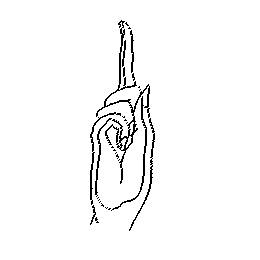 Tarjani Mudrā
Tarjani Mudrā - wēishè yìn 威慑印 / 威懾印
- This gesture consists of one hand held up with the forefinger extended, and is, as among English speakers, a combination of teaching and warning. It is often seen on statues of the Bodhisattva Guānyīn.
- (This gesture seems also to be called qīkè yìn 期克印, the name properly assigned to the Demon-Quelling Gesture or Kāraṇa Mudrā).
- Wheel-Turning Gesture
-
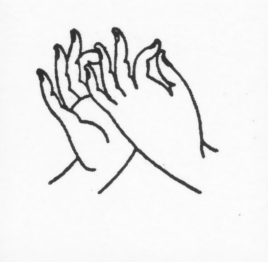 Dharmacakra Mudrā
Dharmacakra Mudrā - zhuǎnfǎlún yìn 转法轮印 / 轉法輪印 or shuōfǎ yìn 说法印 / 說法印
- This gesture refers to turning the wheel of the law or of teaching about the law. It is through turning this great wheel by means of their teachings, that the buddhas guide the world through the six realms of existence also represented by a wheel.
- Wheel imagery to describe reincarnation is pervasive in Buddhist art. Artists tend to show the Buddha making this gesture during his first sermon after his enlightenment, described in the on-line biography of the Buddha (chapter 18 in the version with Sanskrit names, chapter 17 in the version with Chinese names). The same wheel imagery is seen in the tenth court of hell, also described on this web site (link).
- Wisdom Gesture
-
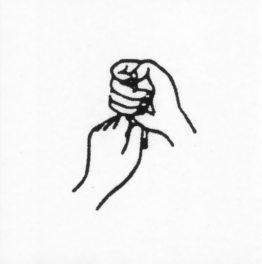 Vajra Mudrā or Jñāna Mudrā or Bodhaśrī Mudrā
Vajra Mudrā or Jñāna Mudrā or Bodhaśrī Mudrā - zhìquán yìn 智拳印
- This gesture indicates supreme knowledge or wisdom. It is made by making a fist with the right hand but extending the first finger, and then grasping that finger with the left hand. The gesture is used in ritual more than art.
- Wish-Granting Gesture
-
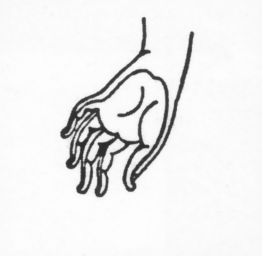 Varada Mudrā or Vara Mudrā
Varada Mudrā or Vara Mudrā - shīyuán yìn 施原印 or yúyuàn yìn 予愿印 / 予願印
- This gesture shows charity and the compassionate granting of wishes. It is usually made with the left hand while the right hand makes a different mudrā, often the "Calm-Down" (Abhaya) mudrā vanquishing fear, discussed above. The gesture is common in representations of Guānyīn 观音 / 觀音, a bodisattva especially associated with compassion.
A review quiz is available covering this page.
Sources
- DĪNG Fúbǎo 丁福保
- 1975 Fóxué dà cídiǎn 佛學大辭典 (Encyclopedic dictionary of Buddhist studies). Táiběi: Dōngxīng Wénhuà Publishing Company 東興文化出版社.
- EITEL, Ernest J.
- 1904 Hand-book of Chinese Budhism, being a Sanskrit-Chinese dictionary with vocabularies of Buddhist terms. 2nd edition. Tokyo: Sanshusha.
- GETTY, Alice
- 1962 The gods of northern Buddhism: their history, iconography, and progressive evolution through the northern Buddhist countries. Tokyo: Charles E. Tuttle Company.
- JANSEN, Eva Rudy
- 1990 The book of buddhas: ritual symbolism used on Buddhist statuary and ritual objects. (Tr. from Dutch by Tony Langam.) Haarlem, Netherlands: Binkey Kok Publications.
- SAUNDERS, E. Dale
- 1950 Mudrā: A study of symbolic gestures in Japanese Buddhist sculpture. New York: Pantheon Books. (Bollingen Series vol. 58.)
- SJOQUIST, Douglas P.
- 1999 Identifying Buddhist images in Japanese painting and sculpture. Education About Asia 4(3): 27-36.
- SOOTHILL, William Edward and Lewis Hodous
- 1937 A dictionary of Chinese Buddhist terms with Sanskrit and English equivalents. London: Kegan Paul-Trench-Trubner.
- Plus countless web sites, many already vanished.
Return to top.
 Abhaya Mudrā or Abhayaṃdada Mudrā
Abhaya Mudrā or Abhayaṃdada Mudrā  Kāraṇa Mudrā
Kāraṇa Mudrā  Bhūmisparśa Mudrā
Bhūmisparśa Mudrā Uttarabodhi Mudrā
Uttarabodhi Mudrā  Dhyāna Mudrā
Dhyāna Mudrā  Añjali Mudrā or Vajra-Añalikarma Mudrā or Namaskara Mudrā
Añjali Mudrā or Vajra-Añalikarma Mudrā or Namaskara Mudrā  Vajrahūmkāra Mudrā or Basara Mudrā
Vajrahūmkāra Mudrā or Basara Mudrā  Vitarka Mudrā or Vyākhyāna Mudrā
Vitarka Mudrā or Vyākhyāna Mudrā  Tarjani Mudrā
Tarjani Mudrā Dharmacakra Mudrā
Dharmacakra Mudrā  Vajra Mudrā or Jñāna Mudrā or Bodhaśrī Mudrā
Vajra Mudrā or Jñāna Mudrā or Bodhaśrī Mudrā  Varada Mudrā or Vara Mudrā
Varada Mudrā or Vara Mudrā 

